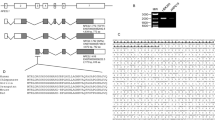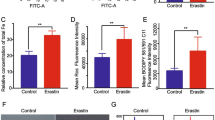Abstract
Ferritin is the major intracellular iron storage protein that sequesters excess free iron to minimize generation of iron-catalysed reactive oxygen species. We previously demonstrated that expression of ferritin heavy chain (ferritin H) was induced by pro-oxidants, which is a part of cellular antioxidant response to protect cells from oxidative damage. In this study, we have identified that the antioxidant/electrophile response element (ARE) located 4.5 kb upstream to the human ferritin H transcription initiation site is responsible for the oxidant response. The human ferritin H ARE comprises two copies of bidirectional AP1 motifs. Mutations in each AP1 motif significantly impaired protein binding and the function of the ARE, indicating that both of the AP1 motifs are required for pro-oxidant-mediated activation of the ferritin H gene. We identified that JunD, an AP1 family basic-leucine zipper (bZip) transcription factor, is one of the ferritin H ARE binding proteins and activates ferritin H transcription in HepG2 hepatocarcinoma cells. Gel retardation assay demonstrated that H2O2 (hydrogen peroxide) or t-BHQ (tert-butylhydroquinone) treatment increased total protein binding as well as JunD binding to the ferritin H ARE. Chromatin immunoprecipitation assay showed that H2O2 treatment induced JunD binding to the ferritin H ARE. Both H2O2 and t-BHQ induced phosphorylation of JunD at Ser-100, an activated form of JunD. Furthermore, overexpression of JunD induced endogenous ferritin H protein synthesis. Since JunD has recently been demonstrated to protect cells from several stress stimuli including oxidative stress, these results suggest that, in addition to NFE2-related factor 2 (Nrf2) as a major ARE regulatory protein, JunD is another ARE regulatory protein for transcriptional activation of the human ferritin H gene and probably other antioxidant genes containing the conserved ARE sequences by which JunD may confer cytoprotection during oxidative stress.
This is a preview of subscription content, access via your institution
Access options
Subscribe to this journal
Receive 50 print issues and online access
$259.00 per year
only $5.18 per issue
Buy this article
- Purchase on Springer Link
- Instant access to full article PDF
Prices may be subject to local taxes which are calculated during checkout







Similar content being viewed by others
Accession codes
References
Ainbinder E, Bergelson S, Pinkus R and Daniel V . (1997). Eur. J. Biochem., 243, 49–57.
Arosio P and Levi S . (2002). Free Radic. Biol. Med., 33, 457–463.
Beaumont C, Jain SK, Bogard M, Nordmann Y and Drysdale J . (1987). J. Biol. Chem., 262, 10619–10623.
Beaumont C, Seyhan A, Yachou A-K, Grandchamp B and Jones R . (1994). J. Biol. Chem., 269, 20281–20288.
Bevilacqua MA, Faniello MC, Quaresima B, Tiano MT, Giuliano P, Feliciello A, Avvedimento VE, Cimino F and Costanzo F . (1997). J. Biol. Chem., 272, 20736–20741.
Bevilacqua MA, Faniello MC, Russo T, Cimino F and Costanzo F . (1998). Biochem. J., 335 (Part 3), 521–525.
Bomford A, Conlon-Hollingshead C and Munro HN . (1981). J. Biol. Chem., 256, 948–955.
Cairo G, Tacchini L, Pogliaghi G, Anzon E, Tomasi A and Bernelli-Zazzera A . (1995). J. Biol. Chem., 270, 700–703.
Choi H-S and Moore DD . (1993). Mol. Endocrinol., 7, 1596–1602.
Chou C-C, Gatti RA, Fuller ML, Concannon P, Wong A, Chada S, Davis RC and Salser WA . (1986). Mol. Cell Biol., 6, 566–573.
Cozzi A, Corsi B, Levi S, Santambrogio P, Albertini A and Arosio P . (2000). J. Biol. Chem., 275, 25122–25129.
Dhakshinamoorthy S and Jaiswal AK . (2000). J. Biol. Chem., 275, 40134–40141.
Epsztejn S, Glickstein H, Picard V, Slotki IN, Breuer W, Beaumont C and Cabantchik ZI . (1999). Blood, 94, 3593–3603.
Faniello MC, Bevilacqua MA, Condorelli G, de Crombrugghe B, Maity SN, Avvedimento VE, Cimino F and Costanzo F . (1999). J. Biol. Chem., 274, 7623–7626.
Friling RS, Bensimon A, Tichauer Y and Daniel V . (1990). Proc. Natl. Acad. Sci. USA, 87, 6258–6262.
Gallo A, Cuozzo C, Esposito I, Maggiolini M, Bonofiglio D, Vivacqua A, Garramone M, Weiss C, Bohmann D and Musti AM . (2002). Oncogene, 21, 6434–6445.
Gerald D, Berra E, Frapart YM, Chan DA, Giaccia AJ, Mansuy D, Pouyssegur J, Yaniv M and Mechta-Grigoriou F . (2004). Cell, 118, 781–794.
Harrison PM and Arosio P . (1996). Biochim. Biophys. Acta, 1275, 161–203.
Hayes JD and McMahon M . (2001). Cancer Lett., 174, 103–113.
Hentze MW and Kuhn LC . (1996). Proc. Natl. Acad. Sci. USA, 93, 8175–8182.
Hentze MW, Muckenthaler MU and Andrews NC . (2004). Cell, 117, 285–297.
Hirota K, Matsui M, Iwata S, Nishiyama A, Mori K and Yodoi J . (1997). Proc. Natl. Acad. Sci. USA, 94, 3633–3638.
Inamdar NM, Ahn YI and Alam J . (1996). Biochem. Biophys. Res. Commun., 221, 570–576.
Jaiswal AK . (1994). Biochem. Pharmacol., 48, 439–444.
Jaiswal AK . (2004). Methods Enzymol., 378, 221–238.
Jindra M, Gaziova I, Uhlirova M, Okabe M, Hiromi Y and Hirose S . (2004). EMBO J., 23, 3538–3547.
Kwak EL, Larochelle DA, Beaumont C, Torti SV and Torti FM . (1995). J. Biol. Chem., 270, 15285–15293.
Kwak MK, Itoh K, Yamamoto M, Sutter TR and Kensler TW . (2001). Mol. Med., 7, 135–145.
Lamb JA, Ventura JJ, Hess P, Flavell RA and Davis RJ . (2003). Mol. Cell, 11, 1479–1489.
Levi S, Luzzago A, Cesareni G, Cozzi A, Franceschinelli F, Albertini A and Arosio P . (1988). J. Biol. Chem., 263, 18086–18092.
Levi S, Santambrogio P, Cozzi A, Rovida E, Corsi B, Tamborini E, Spada S, Albertini A and Arosio P . (1994). J. Mol. Biol., 238, 649–654.
Levi S, Yewdall SJ, Harrison PM, Santambrogio P, Cozzi A, Rovida E, Albertini A and Arosio P . (1992). Biochem. J., 288 (Part 2), 591–596.
Li Y and Jaiswal AK . (1992). J. Biol. Chem., 267, 15097–15104.
Liu S and Pickett CB . (1996). Biochemistry, 35, 11517–11521.
Marziali G, Perrotti E, Ilari R, Testa U, Coccia EM and Battistini A . (1997). Mol. Cell. Biol., 17, 1387–1395.
Meneghini R . (1997). Free Radic. Biol. Med., 23, 783–792.
Miller LL, Miller SC, Torti SV, Tsuji Y and Torti FM . (1991). Proc. Natl. Acad. Sci. USA, 88, 4946–4950.
Motohashi H, O'Connor T, Katsuoka F, Engel JD and Yamamoto M . (2002). Gene, 294, 1–12.
Nakamura H, Nakamura K and Yodoi J . (1997). Annu. Rev. Immunol., 15, 351–369.
Nguyen T, Sherratt PJ and Pickett CB . (2003). Annu. Rev. Pharmacol. Toxicol., 43, 233–260.
Nioi P, McMahon M, Itoh K, Yamamoto M and Hayes JD . (2003). Biochem. J., 374, 337–348.
Orino K, Lehman L, Tsuji Y, Ayaki H, Torti SV and Torti FM . (2001). Biochem. J., 357, 241–247.
Orino K, Tsuji Y, Torti FM and Torti SV . (1999). FEBS Lett., 461, 334–338.
Pham CG, Bubici C, Zazzeroni F, Papa S, Jones J, Alvarez K, Jayawardena S, De Smaele E, Cong R, Beaumont C, Torti FM, Torti SV and Franzoso G . (2004). Cell, 119, 529–542.
Pietsch EC, Chan JY, Torti FM and Torti SV . (2003). J. Biol. Chem., 278, 2361–2369.
Richardson DR and Ponka P . (1997). Biochim. Biophys. Acta, 1331, 1–40.
Rouault TA and Klausner RD . (1996). Trends Biochem. Sci., 21, 174–177.
Rushmore TH, King RG, Paulson KE and Pickett CB . (1990). Proc. Natl. Acad. Sci. USA, 87, 3826–3830.
Rushmore TH, Morton MR and Pickett CB . (1991). J. Biol. Chem., 266, 11632–11639.
Rushmore TH and Pickett CB . (1990). J. Biol. Chem., 265, 14648–14653.
Santambrogio P, Levi S, Arosio P, Palagi L, Vecchio G, Lawson DM, Yewdall SJ, Artymiuk PJ, Harrison PM, Jappelli R and Cesareni G . (1992). J. Biol. Chem., 267, 14077–14083.
Theil EC . (2000). Biochem. Pharmacol., 59, 87–93.
Theil EC . (2003). J. Nutr., 133, 1549S–1553S.
Torti FM and Torti SV . (2002). Blood, 99, 3505–3516.
Torti SV, Kwak EL, Miller SC, Miller LL, Ringold GM, Myambo KB, Young AP and Torti FM . (1988). J. Biol. Chem., 263, 12638–12644.
Tsuji Y, Akebi N, Lam TK, Nakabeppu Y, Torti SV and Torti FM . (1995). Mol. Cell. Biol., 15, 5152–5164.
Tsuji Y, Ayaki H, Whitman SP, Morrow CS, Torti SV and Torti FM . (2000). Mol. Cell. Biol., 20, 5818–5827.
Tsuji Y, Miller LL, Miller SC, Torti SV and Torti FM . (1991). J. Biol. Chem., 266, 7257–7261.
Tsuji Y, Moran E, Torti SV and Torti FM . (1999). J. Biol. Chem., 274, 7501–7507.
Tsuji Y, Ninomiya-Tsuji J, Torti SV and Torti FM . (1993). J. Immunol., 150, 1897–1907.
Vasiliou V, Puga A, Chang C-Y, Tabor MW and Nebert DW . (1995). Biochem. Pharmacol., 50, 2057–2068.
Venugopal R and Jaiswal AK . (1998). Oncogene, 17, 3145–3156.
Vinciguerra M, Vivacqua A, Fasanella G, Gallo A, Cuozzo C, Morano A, Maggiolini M and Musti AM . (2004). J. Biol. Chem., 279, 9634–9641.
Wagstaff M, Worwood M and Jacobs A . (1978). Biochem. J., 173, 969–977.
Wasserman WW and Fahl WE . (1997a). Arch. Biochem. Biophys., 344, 387–396.
Wasserman WW and Fahl WE . (1997b). Proc. Natl. Acad. Sci. USA, 94, 5361–5366.
Weitzman JB, Fiette L, Matsuo K and Yaniv M . (2000). Mol. Cell, 6, 1109–1119.
Wild AC, Moinova HR and Mulcahy RT . (1999). J. Biol. Chem., 274, 33627–33636.
Xanthoudakis S and Curran T . (1992). EMBO J., 11, 653–665.
Xanthoudakis S and Curran T . (1996). Adv. Exp. Med. Biol., 387, 69–75.
Yazgan O and Pfarr CM . (2002). J. Biol. Chem., 277, 29710–29718.
Acknowledgements
We are grateful to Dr Kazushi Inoue at Wake Forest University School of Medicine for helpful advice on ChIP assays. This work was supported by the National Institutes of Health research grant DK-60007 and North Carolina State University Faculty Research and Professional Development Fund SPS0064-9596 to Y Tsuji.
Author information
Authors and Affiliations
Corresponding author
Rights and permissions
About this article
Cite this article
Tsuji, Y. JunD activates transcription of the human ferritin H gene through an antioxidant response element during oxidative stress. Oncogene 24, 7567–7578 (2005). https://doi.org/10.1038/sj.onc.1208901
Received:
Revised:
Accepted:
Published:
Issue Date:
DOI: https://doi.org/10.1038/sj.onc.1208901
Keywords
This article is cited by
-
Decoding the endometrial niche of Asherman’s Syndrome at single-cell resolution
Nature Communications (2023)
-
An iron metabolism and immune related gene signature for the prediction of clinical outcome and molecular characteristics of triple-negative breast cancer
BMC Cancer (2022)
-
Characterization of recombinant protein ferritin from Pyropia yezoensis (rPyFer) and its biological activities
Food Science and Biotechnology (2020)
-
Effects of JUN and NFE2L2 knockdown on oxidative status and NFE2L2/AP-1 targets expression in HeLa cells in basal conditions and upon sub-lethal hydrogen peroxide treatment
Molecular Biology Reports (2019)
-
The cytoprotective role of the Keap1–Nrf2 pathway
Archives of Toxicology (2011)



